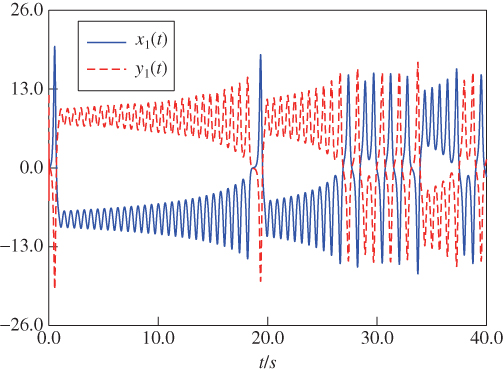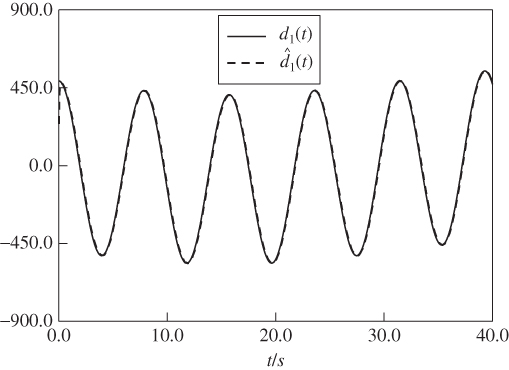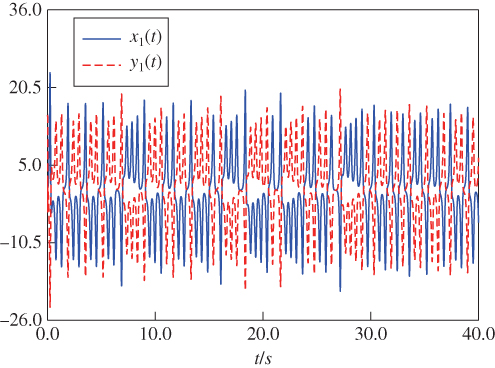Chapter 10
Anti-Synchronization Control for Fractional-Order Nonlinear Systems Using Disturbance Observer and Neural Networks
10.1 Problem Statement
According to the Caputo definition of the fractional derivative (2.17), the fractional-order nonlinear system will be described. Considering the following fractional-order nonlinear system as the master system:
where ![]() denotes the constant matrix,
denotes the constant matrix, ![]() is the state vector,
is the state vector, ![]() is the nonlinear function vector, and the fractional order satisfies
is the nonlinear function vector, and the fractional order satisfies ![]() .
.
The slave system with system uncertainty and external disturbance is given as follows:
where ![]() is the state vector,
is the state vector, ![]() is the nonlinear function vector,
is the nonlinear function vector, ![]() is the unknown bounded disturbance,
is the unknown bounded disturbance, ![]() is the control input, and
is the control input, and ![]() is the system uncertainty.
is the system uncertainty.
This chapter aims to develop a disturbance observer-based anti-synchronization control scheme, so that anti-synchronization is realized between two fractional-order nonlinear systems in the presence of external disturbances and system uncertainties. On the basis of the designed anti-synchronization controller, synchronization errors between the master system and the slave system are convergent under proper conditions. To obtain the main results, the following assumption is introduced.
10.2 Design of Disturbance Observer
In this section, a neural-network-based disturbance observer will be designed to estimate the external disturbance ![]() in the slave system (10.2). On the basis of the slave system (10.2), the following equation of state is given:
in the slave system (10.2). On the basis of the slave system (10.2), the following equation of state is given:
where ![]() is
is ![]() th element of
th element of ![]() ,
, ![]() is the
is the ![]() th element of
th element of ![]() ,
, ![]() is the
is the ![]() th element of
th element of ![]() ,
, ![]() is the
is the ![]() th element of
th element of ![]() ,
, ![]() is the
is the ![]() th element of
th element of ![]() ,
, ![]() is the
is the ![]() th element of
th element of ![]() , and
, and ![]() .
.
On the basis of Lemma 2.4, a neural network is used to approximate the uncertainty ![]() , with
, with ![]() , and Equation (10.3) can be written as
, and Equation (10.3) can be written as
where ![]() .
.
To compensate for the effects of external disturbance ![]() in Equation (10.2), a neural-network-based disturbance observer is designed.
in Equation (10.2), a neural-network-based disturbance observer is designed.
To design the disturbance observer, an auxiliary variable is employed as follows [105]:
where ![]() is a design constant.
is a design constant.
According to Equations (10.4) and (10.5), the Caputo fractional derivative of ![]() can be written as
can be written as
To estimate the auxiliary variable ![]() , we design the estimator as
, we design the estimator as
where ![]() is the estimate of
is the estimate of ![]() and
and ![]() is the estimate of
is the estimate of ![]() .
.
Combining Equations (10.5) and (10.7), the disturbance observer ![]() is given by
is given by
Define the disturbance estimation error ![]() . Considering Equations (10.5) and (10.8), we have
. Considering Equations (10.5) and (10.8), we have
Considering Equations (10.6) and (10.7), the Caputo fractional derivative of ![]() is described as
is described as

where ![]() .
.
According to this design procedure of the neural-network-based disturbance observer, the following theorem is given.
The proof of Theorem 10.1 and the adaptive law of ![]() will be given in the next section.
will be given in the next section.
10.3 Anti-Synchronization Control of Fractional-Order Nonlinear Systems
In this section, a disturbance-observer-based adaptive neural anti-synchronization control scheme will be proposed to guarantee that synchronization errors between the slave system (10.1) and the master system (10.2) are ultimately bounded. To design the anti-synchronization control scheme, the anti-synchronization error state ![]() is defined. On the basis of Equations (10.1) and (10.2), the corresponding anti-synchronization error system is given as
is defined. On the basis of Equations (10.1) and (10.2), the corresponding anti-synchronization error system is given as
The desired anti-synchronization control input is designed as
where ![]() and
and ![]() is a design diagonal positive definite matrix.
is a design diagonal positive definite matrix.
Furthermore, the adaptive law for ![]() is given by
is given by
where ![]() is a design constant,
is a design constant, ![]() is a design constant, and
is a design constant, and ![]() denotes the
denotes the ![]() th element of
th element of ![]() , with
, with ![]() .
.
This design procedure can be summarized in the following theorem.
10.4 Simulation Examples
In this section, the fractional-order Lorenz system [179] and the fractional-order Lü system [187] are used to illustrate the effectiveness of the proposed anti-synchronization control scheme.
10.4.1 Anti-Synchronization Control of Fractional-Order Lorenz System
To illustrate anti-synchronization control of the fractional-order Lorenz system, the model of fractional-order Lorenz system is described as follows [179]:
where ![]() is the fractional order,
is the fractional order, ![]() ,
, ![]() , and
, and ![]() are system state variables, and
are system state variables, and ![]() ,
, ![]() , and
, and ![]() are system parameters. The fractional order is chosen as
are system parameters. The fractional order is chosen as ![]() , the system parameters are set as
, the system parameters are set as ![]() ,
, ![]() , and
, and ![]() , and the initial conditions are chosen as
, and the initial conditions are chosen as ![]() ; the chaotic dynamic behaviors of the fractional-order Lorenz system are shown in Figure 2.1.
; the chaotic dynamic behaviors of the fractional-order Lorenz system are shown in Figure 2.1.
To illustrate the effectiveness of the proposed anti-synchronization controller, the fractional-order Lorenz system (10.32) is regarded as the master system. From Equations (10.2) and (10.32), the slave system is described as follows:
where ![]() ,
, ![]() , and
, and ![]() are system state variables,
are system state variables, ![]() ,
, ![]() , and
, and ![]() are system uncertainties,
are system uncertainties, ![]() ,
, ![]() , and
, and ![]() are unknown bounded disturbances, and
are unknown bounded disturbances, and ![]() ,
, ![]() , and
, and ![]() are designed anti-synchronization control inputs.
are designed anti-synchronization control inputs.
According to Equations (10.32) and (10.33), the corresponding anti-synchronization error system is given as follows:

where ![]() ,
, ![]() , and
, and ![]() are anti-synchronization errors.
are anti-synchronization errors.
To demonstrate the effectiveness of the proposed disturbance-observer-based adaptive neural anti-synchronization control scheme, numerical simulation results are shown for the fractional-order Lorenz system (10.32) under the following conditions: the initial conditions are set as ![]() ,
, ![]() , the designed parameters are chosen as
, the designed parameters are chosen as ![]() ,
, ![]() ,
, ![]() ,
, ![]() ,
, ![]() ,
, ![]() , and
, and ![]() . The disturbances are assumed as
. The disturbances are assumed as ![]() ,
, ![]() , and
, and ![]() . The system uncertainties are chosen as
. The system uncertainties are chosen as ![]() ,
, ![]() , and
, and ![]() .
.
Numerical results are presented under the proposed disturbance-observer-based adaptive neural anti-synchronization control scheme. The state synchronization results of the master system (10.32) and the slave system (10.33) are shown in Figure 10.1, Figure 10.2, and Figure 10.3. It is shown that good synchronization performance is obtained. Figure 10.4 shows that the synchronization errors ![]() ,
, ![]() , and
, and ![]() are convergent. Furthermore, the estimation performance of the proposed disturbance observer (10.7 and 10.8) is shown in Figure 10.5, Figure 10.6, and Figure 10.7. It is evident from Figure 10.8 that the designed disturbance observer is effective and feasible. According to the simulation results, the master system (10.32) and the slave system (10.33) are bounded anti-synchronized under the designed adaptive neural anti-synchronization controller (10.12) and the adaptive update law (10.13). Thus, the proposed disturbance-observer-based adaptive neural anti-synchronization control scheme is valid for fractional-order nonlinear systems with external disturbances and system uncertainties.
are convergent. Furthermore, the estimation performance of the proposed disturbance observer (10.7 and 10.8) is shown in Figure 10.5, Figure 10.6, and Figure 10.7. It is evident from Figure 10.8 that the designed disturbance observer is effective and feasible. According to the simulation results, the master system (10.32) and the slave system (10.33) are bounded anti-synchronized under the designed adaptive neural anti-synchronization controller (10.12) and the adaptive update law (10.13). Thus, the proposed disturbance-observer-based adaptive neural anti-synchronization control scheme is valid for fractional-order nonlinear systems with external disturbances and system uncertainties.

Figure 10.1 Anti-synchronization states of  and
and  of the master system (10.32) and the slave system (10.33).
of the master system (10.32) and the slave system (10.33).

Figure 10.2 Anti-synchronization states of  and
and  of the master system (10.32) and the slave system (10.33).
of the master system (10.32) and the slave system (10.33).

Figure 10.3 Anti-synchronization states of  and
and  of the master system (10.32) and the slave system (10.33).
of the master system (10.32) and the slave system (10.33).

Figure 10.4 Anti-synchronization errors  ,
,  , and
, and  of the master system (10.32) and the slave system (10.33).
of the master system (10.32) and the slave system (10.33).

Figure 10.5 Disturbance estimation result of  and
and  for fractional-order Lorenz system.
for fractional-order Lorenz system.

Figure 10.6 Disturbance estimation result of  and
and  for fractional-order Lorenz system.
for fractional-order Lorenz system.

Figure 10.7 Disturbance estimation result of  and
and  for fractional-order Lorenz system.
for fractional-order Lorenz system.

Figure 10.8 Disturbance observation errors  ,
,  , and
, and  of fractional-order Lorenz system.
of fractional-order Lorenz system.
10.4.2 Anti-Synchronization Control of Fractional-Order Lü System
To further illustrate the effectiveness of the proposed anti-synchronization control scheme, the anti-synchronization of the fractional-order Lü system [187] is studied in this section. For convenience, the fractional-order Lü system is given as follows:
where ![]() is the fractional order,
is the fractional order, ![]() ,
, ![]() , and
, and ![]() are system state variables, and
are system state variables, and ![]() ,
, ![]() , and
, and ![]() are system parameters. For the fractional order
are system parameters. For the fractional order ![]() , system parameters
, system parameters ![]() ,
, ![]() , and
, and ![]() , and initial conditions chosen as
, and initial conditions chosen as ![]() ,
, ![]() , and
, and ![]() , the chaotic dynamic behaviors of the fractional-order Lü system are presented in Figure 2.23.
, the chaotic dynamic behaviors of the fractional-order Lü system are presented in Figure 2.23.
To illustrate the effectiveness of the proposed anti-synchronization controller, the fractional-order Lorenz system (10.32) is regarded as the master system. From Equations (10.2) and (10.32), the slave system is described as follows:
where ![]() ,
, ![]() , and
, and ![]() are system state variables,
are system state variables, ![]() ,
, ![]() , and
, and ![]() are system uncertainties,
are system uncertainties, ![]() ,
, ![]() , and
, and ![]() are unknown bounded disturbances, and
are unknown bounded disturbances, and ![]() ,
, ![]() , and
, and ![]() are designed anti-synchronization control inputs.
are designed anti-synchronization control inputs.
According to Equations (10.32) and (10.33), the corresponding anti-synchronization error system is given as follows:

where ![]() ,
, ![]() , and
, and ![]() are anti-synchronization errors.
are anti-synchronization errors.
For the numerical simulation, we choose the fractional order as ![]() , the disturbances are assumed as
, the disturbances are assumed as ![]() ,
, ![]() , and
, and ![]() , and the system uncertainties are chosen as
, and the system uncertainties are chosen as ![]() ,
, ![]() , and
, and ![]() . The initial conditions are chosen as
. The initial conditions are chosen as ![]() and
and ![]() . The design parameters are chosen as
. The design parameters are chosen as ![]() ,
, ![]() ,
, ![]() ,
, ![]() ,
, ![]() , and
, and ![]() .
.
According to these conditions and the proposed synchronization control scheme, numerical results are presented. Good synchronization performance is shown in Figure 10.9, Figure 10.10, and Figure 10.11. Numerical results of the synchronization errors ![]() ,
, ![]() , and
, and ![]() are given in Figure 10.12, and are bounded and convergent. Furthermore, the observation performance of the proposed disturbance observer (10.7 and 10.8) is presented in Figure 10.13, Figure 10.14, and Figure 10.15. From Figure 10.13, Figure 10.14, Figure 10.15, and Figure 10.16, the disturbance observer is valid. On the basis of the simulation results, the master system (10.35) can anti-synchronize the slave system (10.36) well, based on the designed adaptive neural anti-synchronization controller (10.12) and the adaptive update law (10.13). Therefore, the proposed anti-synchronization control scheme is effective for fractional-order nonlinear systems with external disturbances and system uncertainties.
are given in Figure 10.12, and are bounded and convergent. Furthermore, the observation performance of the proposed disturbance observer (10.7 and 10.8) is presented in Figure 10.13, Figure 10.14, and Figure 10.15. From Figure 10.13, Figure 10.14, Figure 10.15, and Figure 10.16, the disturbance observer is valid. On the basis of the simulation results, the master system (10.35) can anti-synchronize the slave system (10.36) well, based on the designed adaptive neural anti-synchronization controller (10.12) and the adaptive update law (10.13). Therefore, the proposed anti-synchronization control scheme is effective for fractional-order nonlinear systems with external disturbances and system uncertainties.

Figure 10.9 Anti-synchronization states of  and
and  of the master system (10.35) and the slave system (10.36).
of the master system (10.35) and the slave system (10.36).

Figure 10.10 Anti-synchronization states of  and
and  of the master system (10.35) and the slave system (10.36).
of the master system (10.35) and the slave system (10.36).

Figure 10.11 Anti-synchronization states of  and
and  of the master system (10.35) and the slave system (10.36).
of the master system (10.35) and the slave system (10.36).

Figure 10.12 Anti-synchronization errors  ,
,  , and
, and  of the master system (10.35) and the slave system (10.36).
of the master system (10.35) and the slave system (10.36).

Figure 10.13 Disturbance estimation result of  and
and  for the fractional-order Lü system.
for the fractional-order Lü system.

Figure 10.14 Disturbance estimation result of  and
and  for the fractional-order Lü system.
for the fractional-order Lü system.

Figure 10.15 Disturbance estimation result of  and
and  for the fractional-order Lü system.
for the fractional-order Lü system.

Figure 10.16 Observation errors  ,
,  , and
, and  of the fractional-order Lü system.
of the fractional-order Lü system.
10.5 Conclusion
In this chapter, a disturbance-observer-based adaptive neural anti-synchronization control scheme has been studied for fractional-order nonlinear systems in the presence of external disturbances and system uncertainties. A disturbance observer has been developed to estimate the external disturbances. An anti-synchronization controller has been designed based on the disturbance observer and a neural network for the anti-synchronization of fractional-order nonlinear systems in the presence of external disturbances and system uncertainties. Furthermore, numerical simulations of two examples are shown in this chapter, i.e., the fractional-order Lorenz system and the fractional-order Lü system. Numerical simulations show the effectiveness of the proposed disturbance-observer-based adaptive neural anti-synchronization control scheme.








